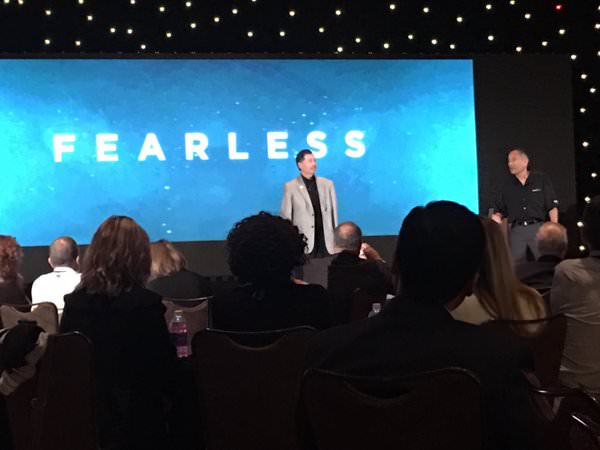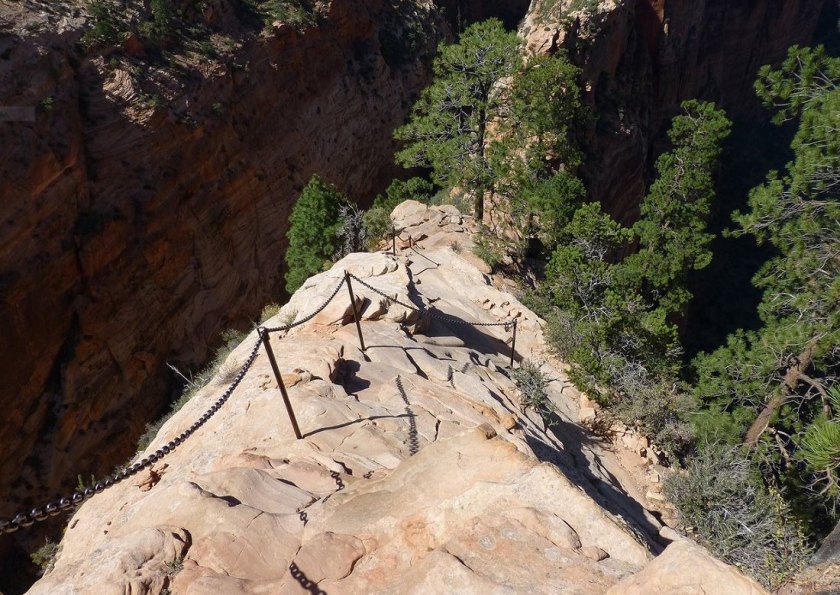
The word ‘fearless’ was literally front and center this year at the digitalNow conference. In the opening and closing sessions, digitalNow’s Hugh Lee and Don Dea talked about the need for association execs to be fearless.
The choice of ‘fearless’ as the unofficial conference motto irked me. I understand why people find ‘fearless’ inspiring. With all the challenges facing associations and the people who run them, you can’t let fear influence your decisions. You can’t hide your head in the sand and avoid dealing with the scary emotions that come with change and conflict.
Does that mean you have to be fearless? No, a thousand times no. You need to be courageous. That’s not the same thing as being fearless.
But ‘fearless’ is a mindset that gets an audience excited. Who doesn’t want to self-identify as someone who doesn’t fear change. Soon after the ‘fearless’ slide went up, tweets with the hashtag #fearless started appearing in the #diginow stream. Hoorah. Yeah, it’s a macho word, for sure. Don’t get me wrong, I have nothing against macho, in fact, I like macho.
Admit it, you’re scared.
Hugh and Don weren’t trying to be macho, they were just acknowledging the state of associations today: “The pace of change can lead to paralyzing fear.”
Fear has a way of disguising itself. Instead of admitting it’s fear that’s holding us back from action, we imagine it’s reason, deliberation, common sense, caution, prudence, tact, wisdom, or some other positive attribute. But not fear, no, we’re more progressive than that, right?
Wrong. If you dig deep and keep asking Why, you may find that fear is lying behind the resistance to change. Rightfully so, we fear the possible consequences of change. We fear the effects of failure. We fear losing our reputation, status, or job.
But, I don’t believe in being fearless. Fearless = foolhardy. Fear is a natural, healthy, and acceptable emotion. It’s an instinct that has saved our butts since our knuckle-dragging days. However, we must acknowledge and be okay with fear instead of letting it become an excuse for inaction.

Fear and courage co-exist.
Fear can help you prepare for what lies ahead. When you figure out what really scares you about something, you can begin to make peace with that fear. Don’t expect to overcome fear, that’s not the point. Instead, learn to live with fear.
One of the scariest things I’ve ever done is hike Angels Landing, a rock formation in Zion National Park. Once a year I hike out west with my boyfriend Jim and his sister Patty who both love the challenge of scary hikes. I don’t have those genes. I can hike long and hike hard, but I’ve never been good with exposure.
Over the years, hiking with these two, I found myself having to deal with more and more exposure on canyon walls and fins. But nothing like Angels Landing. Take a look at this short video and you’ll understand why. And these too, especially the second video. Just watching these made my hands and feet sweat and tingle.
In the weeks leading up to our trip to Zion, I watched dozens of videos like these so I could get used to the exhausting fear I was going to have to deal with on that hike. Fear came along with me on that hike but I kept going up (and down) one step at a time. Was I fearless? Hell, no, but I was courageous and did something I never thought I could do. Jim and Patty said they gave me a 40% shot at making it to the top. They had more faith in me than I did: I had given myself a 30% shot.
Since then, I haven’t missed a chance to talk about this hike. I find all kinds of ways to bring it up, like this post, because I’m proud of my accomplishment. I accepted my fear and walked alongside and through it. And that’s exactly what any of us should do when we’re dealing with change or some other scary thing.

Let fear sit in the backseat.
Identify, if you can, what scares you, your staff, or your board. Acknowledge it, make room for it and walk through that fear. Walking through fear stretches you, and makes you more resilient and stronger. The courageous aren’t fearless, but they take action despite their fear.
I like author Elizabeth Gilbert’s take on fear. In her recent book, Big Magic: Creative Living Beyond Fear, she says, “Fear will always show up—especially when you’re trying to be inventive or innovative…When people try to kill off their fear, they often end up inadvertently murdering their creativity in the process.”
She advises “making space for fear.” She acknowledges its presence and lets it come along for the ride as long as it sits in the back seat. She never lets it drive and doesn’t even allow any backseat driving.
Help others deal with fear.
You must address fear if you want to successfully manage change. You can’t discount people’s feelings of fear, or their feelings of anxiety, stress, or worry. You have to identify and acknowledge that fear and then help them transition through it. I read somewhere that it’s not the ultimate change that people dread, they dread how they’ll feel during the transition.
How well people adapt to change is a function of many variables, but one is the trust they have in you to provide a safe place for change. In a session about culture at digitalNow, moderator Jamie Notter, co-founder of WorkXO, said the innovators on your staff must trust that when they try something that aligns with your organization’s strategy and goals, they won’t be punished.
Make peace with uncertainty.
“Fear comes from uncertainty. So if we can begin, as a group, to identify those issues that worry us, we can begin to attack what often our associations feel are insurmountable odds,” said Hugh during the opening session.
We will always live in uncertainty. In the closing session, Marc Randolph, best known as the founder of Netflix, talked about the need to move forward in uncertainty – an action that goes against everything your self-preserving brain wants you to do. But, as humans, we have to do it to grow, and as organizations, we have to do it to survive.
What fears have you walked alongside and pushed through? I bragged about my Angels Landing experience, now it’s your turn.
<Twitter photo by Sig VanDamme (fearless), Creative Commons licensed photos by Dale Beckett (Angels Landing) and modernrockstar (backseat driver)>
(This post includes an Amazon affiliate link. I receive a tiny commission if you click on the link and purchase the product.)








